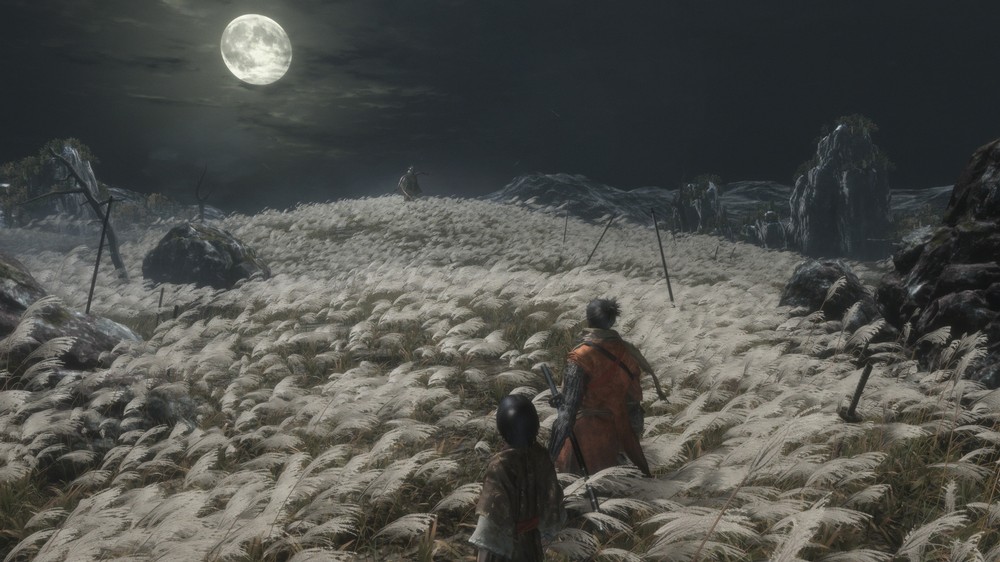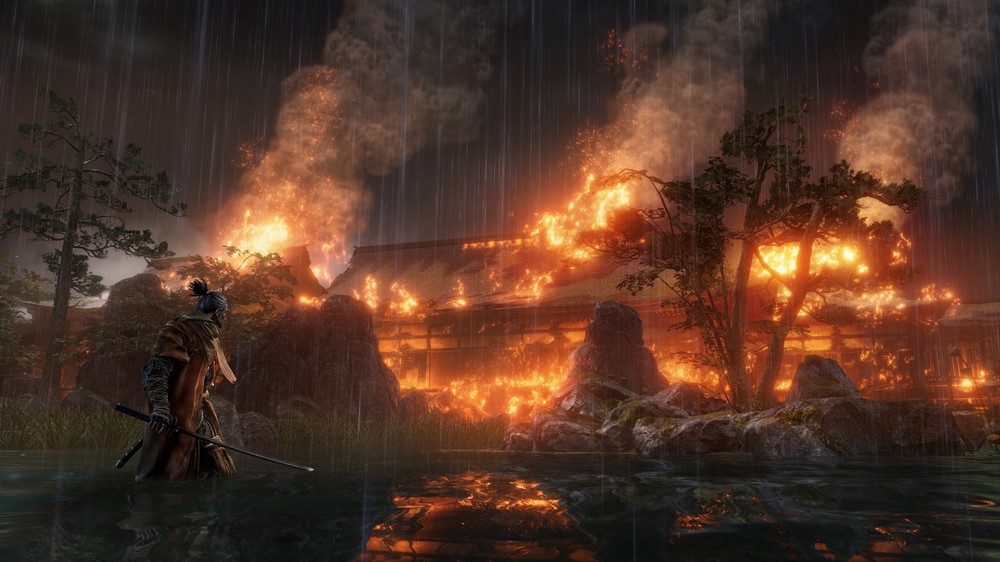Typically, when a FromSoftware title shows up for review I delegate the assignment to someone with more time, patience, and fortitude than myself. History has proven time and time again that Dark Souls and Bloodborne games just aren’t for me – although that seldom stops me from trying them out. But all of the pre-release hype for Sekiro: Shadows Die Twice kept telling me that this game was “different”, so I decided to take my first shot at reviewing one of these “Soulsborne” games. Fifty hours and countless deaths later I just might be ready to talk about my time feudal Japan.
In Sekiro you become the Wolf, a loyal shinobi bodyguard to a young boy, a royal descendent of an ancient bloodline who is promptly kidnapped from your custody in one of the game’s first boss fights. Unlike the brutal boss fights to come this one is scripted to end quickly when your opponent not only takes the child but also your hand. When you eventually recover from your ill-fated encounter you are armed with a prosthetic device, a sword, and an insatiable urge for retribution.
 Sekiro eases you into the game with the standard first-mission tutorial that shows you the ropes for combat, movement, sneaking and eavesdropping, and general gameplay rules, but the onboarding process for this game goes on for hours, and you will find yourself constantly learning new things hours into the adventure. The game also has a rather compelling story that grabs you from the start and definitely helps to incentivize your completion of the game.
Sekiro eases you into the game with the standard first-mission tutorial that shows you the ropes for combat, movement, sneaking and eavesdropping, and general gameplay rules, but the onboarding process for this game goes on for hours, and you will find yourself constantly learning new things hours into the adventure. The game also has a rather compelling story that grabs you from the start and definitely helps to incentivize your completion of the game.
In addition to learning the game’s complex set of rules and systems there are plenty of new attacks and abilities to master. Frequent visits to Hanbei back at your starting temple will allow you to train and master these. I forgot all about him after my initial lessons and it wasn’t long before I was impossibly stuck at a boss fight that required certain tactics I had yet to learn or master with Hanbei. Menus and inventory are a bit clunky to navigate, and between arm attachments and quick-use items boxes there is considerable housekeeping required behind the scenes.
Sekiro is far less linear than its spiritual predecessors. There are no maps or waypoints; just open-world exploration that allows you unprecedented freedom to explore. Sneaky players can bypass entire enemy-filled areas and even skip sub-boss type encounters, but doing so will certainly impact your skills and earned abilities for future encounters. Even so, it’s nice to know that if you get stuck in a certain area you can usually bypass it or come back later. The world is designed with backtracking in mind. Sculptor’s Idols are used to rest, replenish and fast-travel between any other idols you have already discovered. The downside to this is that using an idol to replenish generally repopulates the area with any enemies you have already slain.
 This type of compromise is at the very heart of Sekiro, especially when it comes to death and resurrection. Coming back to life in the middle of combat can be a great strategic tool, but it comes at a great cost with the spread of Dragon Rot, a plague that will afflict the NPC’s in the game and limit your ability to complete side-quests until they are cured. The alternative is to simply die and reload, but this too costs; half my XP and half my gold. There is a chance system in play that might limit these losses, but you are generally punished for everything you do in the game…or so it seems.
This type of compromise is at the very heart of Sekiro, especially when it comes to death and resurrection. Coming back to life in the middle of combat can be a great strategic tool, but it comes at a great cost with the spread of Dragon Rot, a plague that will afflict the NPC’s in the game and limit your ability to complete side-quests until they are cured. The alternative is to simply die and reload, but this too costs; half my XP and half my gold. There is a chance system in play that might limit these losses, but you are generally punished for everything you do in the game…or so it seems.
Sekiro seems brutally unfair at times, but rest assured the game is designed in a way that you always have the tools to win every battle; it’s all about you and your ability to play the game. Every loss can generally be tracked back to your lack of a certain skill or equipped item or even you human ability to finesse the controller. An intricate Shinbo Arts skill tree grants you cool abilities as does an assortment of attachable devices for your prosthetic arm, the most useful of which is your ability to grapple around the environments like samurai Spider-Man.
Ultimately, the game boils down to combat, whether you are going up against a half-dozen guards or facing off against a massive boss or deadly beast. Sekiro is constantly changing the rules of each encounter to keep the combat fresh and evolving, so what worked for one fight likely won’t work on the next. Combat is a healthy mix of attack and defense (mostly defense) with a bit of precision dodging tossed in. There are no patterns to learn and button mashers are brutally punished. Much of the time you are strategically watching your opponent to make their move before you counter or block then follow-up with one of your own. The goal is to slowly wear down their defensive bar then unleash a fatal blow good for taking down lesser enemies, but larger opponents will often require multiple fatal blows to defeat.
 Combat is also about restraint. It’s all too easy to land two or three sequential blows, get excited and push too hard on the attack to have the enemy block and turn the tables in an instant. You really have to immerse yourself into each and every encounter and adapt to enemy fighting styles. In one early encounter I was constantly getting defeated by a guard with a spear only to learn that there was an unlockable ability to counter that exact attack by stepping on his spear. Sure, it’s possible to win that fight without that ability but it was a whole lot easier with it.
Combat is also about restraint. It’s all too easy to land two or three sequential blows, get excited and push too hard on the attack to have the enemy block and turn the tables in an instant. You really have to immerse yourself into each and every encounter and adapt to enemy fighting styles. In one early encounter I was constantly getting defeated by a guard with a spear only to learn that there was an unlockable ability to counter that exact attack by stepping on his spear. Sure, it’s possible to win that fight without that ability but it was a whole lot easier with it.
The presentation for Sekiro: Shadows Die Twice is gorgeous with a rich, detailed world full of authentic landscapes and architecture. The cutscenes are fantastic with hyper-realistic character models and movie-like camera angles. The in-game camera works great and lets you survey each upcoming encounter to plan your attack or find a path to sneak by. Combat animation is perfect and flows at 60fps with each attack and defense animation seamlessly blending into the next. Subtle movements telegraph enemy attacks allowing you just enough time to counter or block. The entire package is wrapped up with an outstanding soundtrack and authentic voice acting but prepare to read subtitles as this is a Japanese only voiced game.
Sekiro is not for casual gamers, and in many ways it might not even be for fans of previous “Soulsborne” games. While Sekiro might share the same difficulty as Dark Souls or Bloodborne the very core of the combat is vastly different from anything FromSoftware has done before and could put off fans of the developer. But where Sekiro truly shines is in that feeling of accomplishment you get when you finally beat that 45-minute boss fight or even just nailing that perfect parry and counterattack. Sekiro: Shadows Die Twice might be brutally difficult, but it is also genuinely rewarding.

















